L-isocorypalmine reduces behavioral sensitization and rewarding effects of cocaine in mice by acting on dopamine receptors
- PMID: 24080315
- PMCID: PMC3954112
- DOI: 10.1016/j.drugalcdep.2013.08.021
L-isocorypalmine reduces behavioral sensitization and rewarding effects of cocaine in mice by acting on dopamine receptors
Abstract
Background: We previously reported isolation of l-isocorypalmine (l-ICP), a mono-demethylated analog of l-tetrahydropalmatine (l-THP), from the plant Corydalis yanhusuo. Here we characterized its in vitro pharmacological properties and examined its effects on cocaine-induced behaviors in mice.
Methods: Receptor binding, cAMP and [(35)S]GTPγS assays were used to examine pharmacological actions of l-ICP in vitro. Effects of l-ICP on cocaine-induced locomotor hyperactivity and sensitization and conditioned place preference (CPP) in mice were investigated. HPLC was employed to analyze metabolites of l-ICP in mouse serum.
Results: Among more than 40 targets screened, l-ICP and l-THP bound only to dopamine (DA) receptors. l-ICP was a high-affinity partial agonist of D1 and D5 receptors and a moderate-affinity antagonist of D2, D3 and D4 receptors, whereas l-THP bound to only D1 and D5 receptors, with lower affinities than l-ICP. At 10mg/kg (i.p.), l-ICP inhibited spontaneous locomotor activity for a shorter time than l-THP. Pretreatment with l-ICP reduced cocaine-induced locomotor hyperactivities. Administration of l-ICP before cocaine once a day for 5 days reduced cocaine-induced locomotor sensitization on days 5 and 13 after 7 days of withdrawal. Pretreatment with l-ICP before cocaine daily for 6 days blocked cocaine-induced CPP, while l-ICP itself did not cause preference or aversion. HPLC analysis showed that l-ICP was the main compound in mouse serum following i.p. injection of l-ICP.
Conclusions: l-ICP likely acts as a D1 partial agonist and a D2 antagonist to produce its in vivo effects and may be a promising agent for treatment of cocaine addiction.
Keywords: Cocaine; Conditioned place preference; Dopamine receptor; Isocorypalmine; Sensitization; Tetrahydropalmatine.
Copyright © 2013 Elsevier Ireland Ltd. All rights reserved.
Conflict of interest statement
There are no conflicts of interest.
Figures

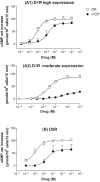
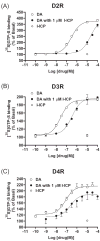

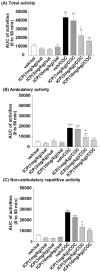
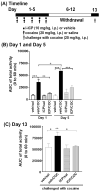
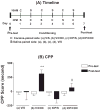

Similar articles
-
Differential ability of D1 and D2 dopamine receptor agonists to induce and modulate expression and reinstatement of cocaine place preference in rats.Psychopharmacology (Berl). 2007 Apr;191(3):719-30. doi: 10.1007/s00213-006-0473-5. Epub 2006 Jul 12. Psychopharmacology (Berl). 2007. PMID: 16835769
-
Levo-tetrahydropalmatine inhibits cocaine's rewarding effects: experiments with self-administration and brain-stimulation reward in rats.Neuropharmacology. 2007 Nov;53(6):771-82. doi: 10.1016/j.neuropharm.2007.08.004. Epub 2007 Aug 15. Neuropharmacology. 2007. PMID: 17888459 Free PMC article.
-
Levo-tetrahydropalmatine attenuates cocaine self-administration and cocaine-induced reinstatement in rats.Psychopharmacology (Berl). 2007 Jul;192(4):581-91. doi: 10.1007/s00213-007-0754-7. Epub 2007 Mar 15. Psychopharmacology (Berl). 2007. PMID: 17361394
-
Levo-tetrahydropalmatine: A new potential medication for methamphetamine addiction and neurotoxicity.Exp Neurol. 2021 Oct;344:113809. doi: 10.1016/j.expneurol.2021.113809. Epub 2021 Jul 10. Exp Neurol. 2021. PMID: 34256045 Review.
-
Recent development in studies of tetrahydroprotoberberines: mechanism in antinociception and drug addiction.Cell Mol Neurobiol. 2008 Jun;28(4):491-9. doi: 10.1007/s10571-007-9179-4. Epub 2007 Aug 21. Cell Mol Neurobiol. 2008. PMID: 17710533 Free PMC article. Review.
Cited by
-
Dopamine D1-Like Receptor Agonist and D2-Like Receptor Antagonist (-)-Stepholidine Reduces Reinstatement of Drug-Seeking Behavior for 3,4-Methylenedioxypyrovalerone (MDPV) in Rats.ACS Chem Neurosci. 2018 Jun 20;9(6):1327-1337. doi: 10.1021/acschemneuro.7b00510. Epub 2018 Apr 6. ACS Chem Neurosci. 2018. PMID: 29597343 Free PMC article.
-
Recent progress on the traditional Chinese medicines that regulate the blood.J Food Drug Anal. 2016 Apr;24(2):221-238. doi: 10.1016/j.jfda.2015.10.009. Epub 2016 Jan 5. J Food Drug Anal. 2016. PMID: 28911575 Free PMC article. Review.
-
Tetrahydroprotoberberine alkaloids with dopamine and σ receptor affinity.Bioorg Med Chem. 2016 May 1;24(9):2060-71. doi: 10.1016/j.bmc.2016.03.037. Epub 2016 Mar 21. Bioorg Med Chem. 2016. PMID: 27032890 Free PMC article.
-
Comparison of Pharmacological Properties between the Kappa Opioid Receptor Agonist Nalfurafine and 42B, Its 3-Dehydroxy Analogue: Disconnect between in Vitro Agonist Bias and in Vivo Pharmacological Effects.ACS Chem Neurosci. 2020 Oct 7;11(19):3036-3050. doi: 10.1021/acschemneuro.0c00407. Epub 2020 Sep 24. ACS Chem Neurosci. 2020. PMID: 32897695 Free PMC article.
-
Candidate Chinese Herbal Medicine Alleviates Methamphetamine Addiction via Regulating Dopaminergic and Serotonergic Pathways.Front Mol Neurosci. 2022 Mar 29;15:874080. doi: 10.3389/fnmol.2022.874080. eCollection 2022. Front Mol Neurosci. 2022. PMID: 35422687 Free PMC article.
References
-
- Abrahams BS, Rutherford JD, Mallet PE, Beninger RJ. Place conditioning with the dopamine D1-like receptor agonist SKF 82958 but not SKF 81297 or SKF 77434. Eur J Pharmacol. 1998;343:111–118. - PubMed
-
- Barton AC, Black LE, Sibley DR. Agonist-induced desensitization of D2 dopamine receptors in human Y-79 retinoblastoma cells. Mol Pharmacol. 1991;39:650–658. - PubMed
-
- Berglind WJ, Case JM, Parker MP, Fuchs RA, See RE. Dopamine D1 or D2 receptor antagonism within the basolateral amygdala differentially alters the acquisition of cocaine-cue associations necessary for cue-induced reinstatement of cocaine-seeking. Neuroscience. 2006;137:699–706. - PubMed
-
- Caine SB, Negus SS, Mello NK. Effects of dopamine D(1-like) and D(2-like) agonists on cocaine self-administration in rhesus monkeys: rapid assessment of cocaine dose-effect functions. Psychopharmacology (Berl) 2000;148:41–51. - PubMed
Publication types
MeSH terms
Substances
Grants and funding
LinkOut - more resources
Full Text Sources
Other Literature Sources
Medical

